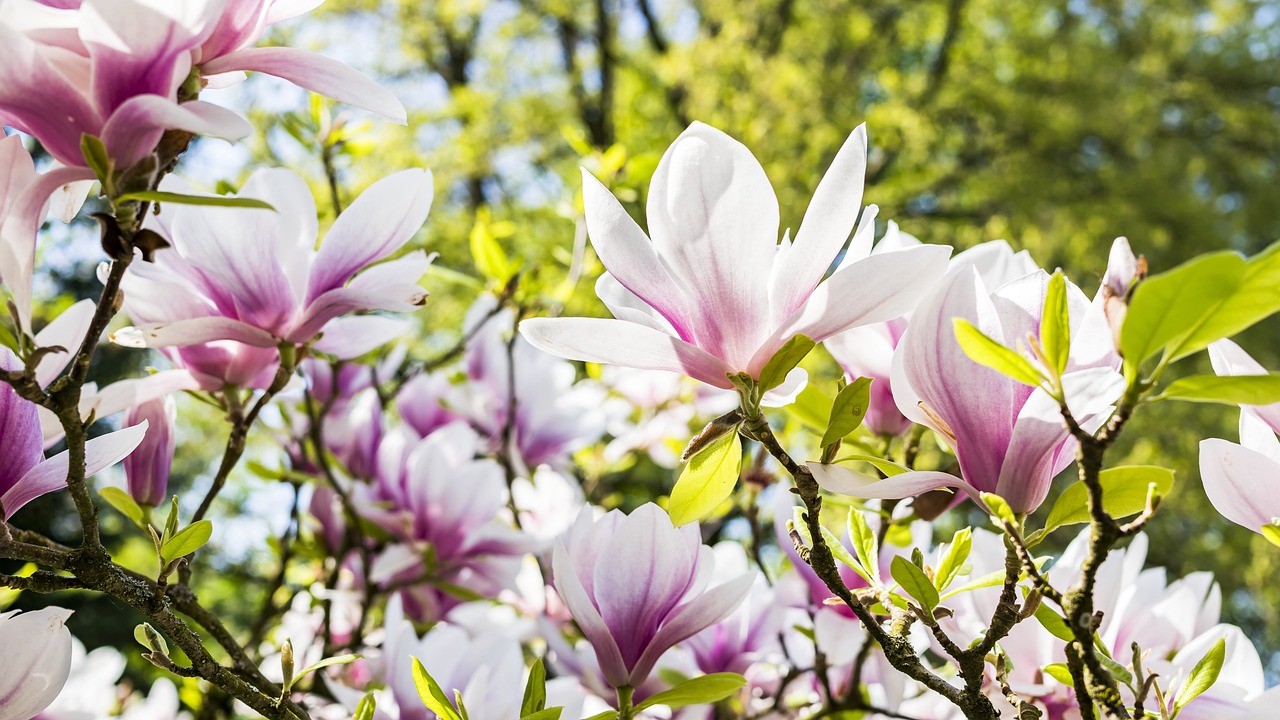I. Introduction
A. Introduction to Propagating Magnolia Trees with Softwood Cuttings
When it comes to creating new magnolia trees, there are several methods to choose from. One of the most rewarding and efficient techniques is propagating magnolia trees with softwood cuttings.
In this comprehensive guide, we will walk you through the steps required to successfully propagate these magnificent flowering trees using softwood cuttings.
B. Benefits of Using Softwood Cuttings for Propagation
Before we dive into the nitty-gritty details, it’s essential to understand why softwood cuttings are the method of choice for many avid gardeners and horticulturists.
Softwood cuttings offer numerous advantages that make them an attractive option for propagating magnolia trees.
C. The Importance of Proper Timing
Timing is everything in the world of softwood cuttings. To maximize your chances of success, you’ll need to take these cuttings at precisely the right time.
Throughout this guide, we will emphasize the significance of proper timing and provide insights into when to embark on this propagation journey.
II. Understanding Softwood Cuttings
A. What are Softwood Cuttings?
Softwood cuttings are a specialized form of plant propagation that involves taking young, tender stems or branches from a parent plant. These cuttings are characterized by their flexibility and the fact that they haven’t fully matured or hardened yet.
They are typically harvested during the spring or early summer when the plant’s growth is vigorous.
B. Why Softwood Cuttings for Magnolia Propagation?
When it comes to magnolia trees, softwood cuttings are the method of choice due to their exceptional success rate. These cuttings root quickly and reliably, ensuring that you can grow new magnolia trees that closely resemble the parent tree.
This method is particularly advantageous if you want to preserve specific traits or features of your favorite magnolia variety.
C. Advantages and Disadvantages
Advantages of Softwood Cuttings
- High Success Rate: Softwood cuttings have a remarkable ability to root and establish themselves as new plants.
- Rapid Growth: You’ll witness signs of root development in a relatively short period, compared to other propagation methods.
- Preservation of Traits: Cloned plants from softwood cuttings retain the desirable characteristics of the parent tree.
- Cost-Efficiency: Softwood cuttings are a cost-effective way to expand your collection of magnolia trees.
Disadvantages of Softwood Cuttings
- Timing Sensitivity: Success hinges on taking cuttings at the right stage of growth.
- Environmental Vulnerability: Softwood cuttings are sensitive to changes in humidity, temperature, and light.
- Seasonal Limitation: This method is typically employed during the spring or early summer when new growth is most prevalent.
In the following sections, we’ll delve deeper into the process of taking and propagating softwood cuttings from magnolia trees, equipping you with the knowledge needed to excel in this effective propagation technique.
III. Preparing for Propagation
A. Materials and Tools for Softwood Cutting Propagation
Before you embark on propagating magnolia trees with softwood cuttings, gather the necessary materials and tools. Here’s a list of what you’ll need:
Materials:
- Softwood Cuttings: The primary material, young and healthy magnolia branches with tender growth.
- Rooting Hormone: A rooting hormone powder or gel to encourage root development.
- Growing Medium: A well-draining, sterile potting mix or propagation medium.
- Pots or Trays: Containers for planting your cuttings.
- Labels: Waterproof labels to identify different magnolia varieties.
- Misting System: A misting system or spray bottle for maintaining humidity.
- Plastic Bags or Domes: To create a mini greenhouse environment for the cuttings.
Tools:
- Pruning Shears or Secateurs: Clean and sharp for taking cuttings.
- A Sharp Knife: For making precise cuts on the branches.
- Small Shovel or Dibble: To create holes for planting cuttings.
- Spray Bottle: For misting the cuttings.
- Garden Gloves: To protect your hands during the process.
- Pencil or Planting Dibble: For making planting holes in the growing medium.
B. Selecting a Healthy Donor Magnolia Tree
Choosing the right donor tree is crucial for successful softwood cutting propagation. Here are some tips for selecting a healthy donor magnolia tree:
Characteristics of a Healthy Donor Tree:
- Vigorous Growth: Look for a tree that’s actively growing with lush, green foliage.
- No Signs of Disease or Pests: Ensure the tree is free from any visible signs of disease or insect infestations.
- Well-Established: Opt for a mature magnolia tree that’s been in the ground for a few years.
- Desirable Traits: If you’re propagating for specific traits, select a tree that exhibits those characteristics, such as particular flower color or size.
C. Timing for Softwood Cuttings
Timing is critical when it comes to taking softwood cuttings from magnolia trees. The best time to take softwood cuttings is typically in the late spring to early summer, usually around June.
This is when the branches are still young and flexible, making them ideal for propagation. Avoid taking cuttings during extreme heat or drought conditions, as this can reduce their success rate.
IV. Taking Softwood Cuttings
A. Identifying Suitable Branches for Cuttings
Not all branches are suitable for softwood cuttings. To select the right ones, follow these guidelines:
Characteristics of Suitable Branches:
- Young and Flexible: Choose branches that are relatively young and flexible, usually found towards the tips of the tree’s branches.
- No Flowers or Buds: Avoid branches with flowers or buds, as they divert energy away from root development.
- Healthy Leaves: Select branches with healthy, green leaves and no signs of damage or disease.
- 6-8 Inches in Length: Aim for cuttings that are 6 to 8 inches long, with at least 2-3 sets of leaves.
B. Proper Technique for Taking Softwood Cuttings
Taking softwood cuttings requires precision and care. Follow these steps for the proper technique:
Steps for Taking Softwood Cuttings:
- Use Clean Tools: Ensure your pruning shears or knife are clean and sharp to make clean cuts.
- Select the Cutting: Choose a branch that meets the criteria mentioned earlier.
- Make the Cut: Cut the branch just below a leaf node, using a sharp 45-degree angle.
- Remove Leaves: Strip the lower leaves from the cutting, leaving only a few leaves at the top.
- Apply Rooting Hormone: Dip the cut end in rooting hormone to encourage root development.
C. Importance of Clean and Sharp Tools
Using clean and sharp tools is vital when taking softwood cuttings to prevent damage to both the parent tree and the cuttings.
Clean tools reduce the risk of introducing diseases to your magnolia tree and ensure clean, smooth cuts that facilitate successful propagation. Regularly sterilize your tools with rubbing alcohol or a bleach solution to maintain their cleanliness throughout the process.
V. Preparing Cuttings for Planting
A. Steps for Preparing the Cuttings
Properly preparing your softwood cuttings is essential for successful propagation. Follow these steps to prepare your cuttings for planting:
1. Trim the Cuttings:
- Using clean and sharp pruning shears or a knife, trim the bottom of each cutting just below a leaf node.
- Make sure the cut is clean and at a 45-degree angle.
2. Remove Excess Leaves:
- Strip the lower leaves from the cutting, leaving only a few leaves at the top.
- This reduces water loss through transpiration and encourages energy to be directed towards root development.
B. Use of Rooting Hormone and Application
Rooting hormone is a valuable aid in softwood cutting propagation, as it encourages the development of roots. Here’s how to apply it effectively:
1. Choose the Right Rooting Hormone:
- Select a rooting hormone powder or gel suitable for softwood cuttings.
2. Dip the Cut End:
- Dip the freshly cut end of each cutting into the rooting hormone.
- Ensure that the hormone coats the cut surface evenly.
3. Shake Off Excess:
- Gently shake off any excess rooting hormone to prevent overapplication, which can hinder root development.
C. Proper Labeling for Tracking Varieties
To keep track of different magnolia varieties and ensure you can identify them once they start growing, proper labeling is crucial:
1. Waterproof Labels:
- Use waterproof labels to identify each cutting or tray.
- Include the date of propagation, the magnolia variety, and any other relevant information.
2. Organization:
- Keep a record or diagram of where you’ve planted each variety in your growing medium or propagation trays.
- This will help you monitor their progress and ensure you can transplant them accurately later on.
VI. Planting Softwood Cuttings
A. Choice of Growing Medium
Selecting the right growing medium is key to providing your softwood cuttings with the ideal environment for root development:
1. Potting Mix or Propagation Tray:
- You can use a well-draining potting mix or a specialized propagation tray filled with a suitable medium.
- Ensure the medium is sterile to prevent the introduction of diseases.
B. Inserting the Cuttings
Properly inserting the cuttings into the growing medium is essential for successful root development:
1. Create Planting Holes:
- Use a small shovel, dibble, or your finger to create planting holes in the growing medium.
- The holes should be deep enough to accommodate the cuttings without bending them.
2. Insert the Cuttings:
- Gently insert the cut end of each cutting into a planting hole.
- Ensure the leaves are above the surface while the cut end is buried in the medium.
C. Spacing and Positioning
Maintaining the correct spacing and positioning of the cuttings is crucial for optimal growth:
1. Adequate Spacing:
- Space the cuttings several inches apart to allow for proper air circulation and prevent overcrowding.
2. Positioning:
- Position the cuttings upright in the planting holes, ensuring they remain stable.
With your cuttings properly prepared and planted in the growing medium, you’ve set the stage for the next critical phase of softwood cutting propagation: caring for and nurturing these young magnolia plants until they develop strong roots and are ready for transplanting.
VII. Caring for Softwood Cuttings
A. Ideal Environmental Conditions for Rooting Magnolia Cuttings
Creating the right environment is crucial for the successful root development of your magnolia cuttings. Here’s what you need to know:
1. Light:
- Place your cuttings in an area with bright, indirect sunlight.
- Avoid exposing them to intense, direct sunlight, which can cause excessive drying.
2. Temperature:
- Maintain a consistent temperature range of 70-75°F (21-24°C) for optimal rooting.
- Use a heating mat if necessary to provide consistent warmth.
3. Humidity:
- High humidity is essential for softwood cuttings. Aim for humidity levels of 80% or higher.
- You can achieve this by using a plastic dome or covering the cuttings with plastic bags.
B. Importance of Humidity and Temperature Control
Humidity and temperature play critical roles in the success of your softwood cuttings:
1. Humidity Control:
- High humidity reduces moisture loss through transpiration and promotes root growth.
- Use a misting system or spray bottle to maintain humidity around the cuttings.
- Keep the plastic covering or dome in place to trap moisture.
2. Temperature Control:
- Consistent warmth accelerates root development and ensures the cuttings remain healthy.
- Use a thermometer to monitor and adjust the temperature as needed.
C. Watering, Misting, and Ventilation Requirements
Proper watering and ventilation are vital aspects of caring for softwood cuttings:
1. Watering:
- Keep the growing medium consistently moist but not waterlogged.
- Use a watering can with a fine spray to avoid disturbing the cuttings.
2. Misting:
- Regularly mist the cuttings to maintain high humidity levels.
- Aim to keep the leaves and surrounding air moist.
3. Ventilation:
- Ensure proper air circulation to prevent the buildup of excess moisture and the risk of fungal diseases.
- If using plastic domes or bags, periodically lift them to allow fresh air in and excess humidity to escape.
VIII. Monitoring Progress
A. Checking for Root Development
Monitoring the progress of your softwood cuttings is an exciting part of the propagation process. Here’s how to check for root development:
1. Gently Tug:
- After a few weeks, gently tug on a cutting to see if it resists being pulled up. Resistance indicates root development.
2. Visual Inspection:
- Carefully lift a few cuttings to inspect the root systems.
- Look for the appearance of small, white roots emerging from the base of the cuttings.
B. Timeline for Root Formation
While the exact timing can vary depending on factors like temperature and humidity, you can generally expect root development to occur within 4 to 8 weeks. Some varieties may root more quickly than others, so patience is key.
C. Signs of Successful Propagation
Successful propagation is marked by clear signs of growth and root development:
1. Healthy Foliage:
- Vibrant, green leaves are a positive indicator that the cuttings are thriving.
- New growth may also become visible.
2. Root Growth:
- As roots develop, you’ll notice an increase in stability when gently tugging on the cuttings.
- Carefully inspect the root systems for visible growth.
3. Gradual Acclimatization:
- Once roots have formed, gradually acclimatize the cuttings to outdoor conditions to prepare them for transplanting.
By carefully monitoring the progress of your softwood cuttings, you’ll be able to determine when they are ready for the next stage of their journey, whether that’s transplantation or continued growth in their current environment.
IX. Transplanting Rooted Cuttings
A. Transplanting Rooted Cuttings
Transplanting your rooted magnolia cuttings is the next crucial step in their journey towards becoming mature trees. Here’s how to do it:
1. Choose a Suitable Location:
- Select a well-drained area in your garden that receives partial to full sunlight.
- Ensure there is enough space for the mature magnolia tree to grow.
2. Prepare the Soil:
- Make sure the soil is well-prepared by amending it with organic matter.
- Ensure the soil pH is within the appropriate range for magnolias, typically slightly acidic to neutral.
3. Dig a Hole:
- Dig a hole in the prepared location that’s deep and wide enough to accommodate the root ball of your young magnolia plant.
4. Gently Remove the Cutting:
- Carefully remove the rooted cutting from its pot or growing medium.
- Handle the plant with care to avoid damaging the delicate roots.
5. Plant at the Right Depth:
- Position the young magnolia tree in the center of the hole at the same depth it was previously growing.
- Backfill the hole with soil, ensuring that the plant stands upright.
6. Water Thoroughly:
- Water the newly planted magnolia thoroughly to settle the soil and remove air pockets.
- Keep the soil consistently moist during the establishment phase.
B. Acclimating Young Magnolia Plants to Outdoor Conditions
Acclimating young magnolia plants to outdoor conditions is essential to help them transition successfully:
1. Gradual Exposure:
- Over a period of 1-2 weeks, gradually expose the young magnolia to outdoor conditions.
- Start with a few hours of morning sunlight and increase the exposure gradually.
2. Protect from Harsh Elements:
- Shield the plant from extreme heat, strong winds, and heavy rains during the acclimation period.
- Consider using shade cloth or windbreaks if necessary.
3. Monitor and Adjust:
- Keep a close eye on the plant’s health during acclimation.
- If you notice any stress, reduce outdoor exposure and gradually increase it once the plant recovers.
X. Troubleshooting Common Issues
A. Identifying Potential Problems
While propagating magnolia trees with softwood cuttings is generally straightforward, you may encounter some challenges along the way. Here are common issues to watch out for:
1. Fungal Diseases:
- Damp conditions can lead to fungal diseases like powdery mildew or root rot.
- Symptoms include white powdery spots on leaves or wilting.
2. Poor Root Development:
- If you observe limited or no root development, it may indicate issues with soil quality or moisture levels.
- Yellowing or browning leaves may also be signs of poor root development.
B. Solutions and Tips
To overcome these challenges, consider the following solutions and tips:
1. Fungal Diseases:
- Improve air circulation around the cuttings by providing adequate ventilation.
- Avoid overwatering and keep the leaves dry to prevent fungal growth.
- Use a fungicide treatment if fungal diseases persist.
2. Poor Root Development:
- Check the moisture levels in the growing medium; it should be consistently moist but not waterlogged.
- Ensure the cuttings receive sufficient light for photosynthesis and root development.
- If root development remains an issue, consider using a different growing medium or adjusting your watering routine.
By addressing these common issues and following the troubleshooting tips, you can enhance your chances of successful magnolia tree propagation through softwood cuttings.
Remember that each situation may be unique, so adapt your approach as needed to ensure the health and vitality of your young magnolia plants.
XI. Conclusion
A. Summarizing the Key Steps
In summary, propagating magnolia trees with softwood cuttings can be a rewarding and effective way to grow new trees that mirror the characteristics of your favorite varieties. Let’s recap the key steps in this propagation method:
1. Preparing for Propagation:
- Gather the necessary materials and tools.
- Select a healthy donor magnolia tree.
- Time your cuttings for the late spring or early summer.
2. Taking Softwood Cuttings:
- Choose suitable branches with young, flexible growth.
- Make clean cuts just below leaf nodes.
- Use rooting hormone for enhanced root development.
3. Preparing Cuttings for Planting:
- Trim and remove excess leaves.
- Label cuttings for tracking different varieties.
4. Planting Softwood Cuttings:
- Select an appropriate growing medium.
- Insert cuttings into the medium, maintaining proper spacing and positioning.
5. Caring for Softwood Cuttings:
- Create the ideal environmental conditions, including light, temperature, humidity, and ventilation.
- Regularly water, mist, and monitor the cuttings.
6. Monitoring Progress:
- Check for root development and observe signs of successful propagation.
B. Reiterating the Benefits
The benefits of using softwood cuttings for magnolia propagation are numerous:
- High Success Rate: Softwood cuttings root easily, providing a reliable method for propagation.
- Quick Results: You’ll see signs of root development relatively quickly.
- Preservation of Traits: Cloned plants retain the desirable characteristics of the parent tree.
- Cost-Efficiency: Softwood cuttings offer a cost-effective way to expand your magnolia collection.



